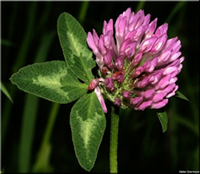abgeschlossene Projekte
Comparative transcriptome analysis and phenotypic monitoring of Trifolium pratense (red clover, Fabaceae) under land use scenarios (TRATSCH)

Funding: 2014 – now, German Research Foundation (DFG)
Co-PI’s: Birgit Gemeinholzer and Volker Wissemann (Institute of Botany, JLU Gießen)
Cooperation partners: Alexander Goesmann and Oliver Rupp, Institute for Bioinformatics and Systems Biology, JLU Gießen
Contact: Annette Becker
Revealing ancestral functions of TCP transcription factors
Plants show a striking morphological variation in nature. This project aims to explain some aspects of the diversity observed by analyzing members of the plant specific TCP domain transcription factors. These genes are strongly conserved within higher plants but still the biological function for several of them remains obscure, for those whose functions are characterized it was shown that they all control plant growth and development. In the proposed joint project we aim to identify functions for CYCLOIDEA (CYC) genes, some of which have been shown to control flower symmetry in species with bilateral symmetry and are hence of special importance to the pollination syndromes.
The aim of this project is to understand the origin and evolution of CYC-like genes and to reveal ancestral function of these transcription factor encoding genes.
Funding: 2015 – 2017, German Academic Exchange Service (DAAD)
Co-PI: Paula Elomaa, University of Helsinki, Finnland
Contact: Annette Becker
Understanding the molecular mechanisms underlying convergent evolution of the gynoecium architecture
The fruits and grains we eat are largely derived from carpels of flowering plants (angiosperms). Carpels, the female reproductive organs, are the unifying character (autapomorphy) of angiosperms. Many components and interactions of the genetic regulatory network (GRN) that orchestrates the development of this complex organ are well characterized in the model species Arabidopsis thaliana. Yet, the origin and conservation of the carpel’s developmental program remains mysterious, as functional data from non-Brassicaceae are lacking to a large extent.
The main aim of this study is to identify the common components and regulatory mechanisms orchestrating carpel development in dicotyledonous plants, among which many carry agronomically valued seeds and fruits. We aim to (1) identify common regulatory mechanisms and distinguish those from the specific ones, (2) identify conserved regulatory modules within the carpel GRN, (3) analyze a case of convergent evolution in carpel development.
We will characterize the carpel development transcription factor interactomes of three genetically tractable model species, A. thaliana and the two basal eudicot species Eschscholzia californica and Aquilegia coerulea. While the gynoecium (sum of all carpels) of A. coerulea is structurally comparatively simple with four to six free carpels, A. thaliana and E. californica show similar, more derived carpel morphologies, both with two carpels fused fully along their margins. We will analyze phylogenies to identify candidate genes, carry out protein interaction analysis and use bioinformatics tools to identify and visualize protein interactions and their evolution. Gene function analysis in basal eudicot species will be carried out using Virus-Induced-Gene Silencing to infer the conservation of gene functions.
Using these combined approaches we will be able to identify common carpel GRN hubs that are essential for carpel morphology across the dicots. These hubs will, in the medium-term provide marker genes to improve yield in dicot crop plants.
Funding: 2016 – 2017, German Academic Exchange Service (DAAD)
Co-PI: Stefan de Folter, CINVESTAV-IPN, Irapuato, Mexico
Contact: Annette Becker
